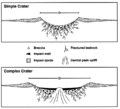Astronomy:(144898) 2004 VD17
| Discovery | |
|---|---|
| Discovered by | LINEAR |
| Discovery date | 7 November 2004 |
| Designations | |
| Minor planet category |
|
| Orbital characteristics[1] | |
| Epoch 2022-Jan-21 (JD 2459600.5) | |
| Uncertainty parameter 0 | |
| Observation arc | 17.8 years |
| |{{{apsis}}}|helion}} | 2.3958 astronomical unit|AU (358.41 million km) |
| |{{{apsis}}}|helion}} | 0.62008 AU (92.763 million km) |
| 1.5079 AU (225.58 million km) | |
| Eccentricity | 0.58878 |
| Orbital period | 1.85 yr (676.34 d) |
| Mean anomaly | 133.93° |
| Mean motion | 0° 31m 56.428s / day |
| Inclination | 4.2239° |
| Longitude of ascending node | 224° |
| 90.97° | |
| Earth MOID | 0.0015 AU (220,000 km) |
| Physical characteristics | |
| Mean diameter | 320m[2] 580m (assumed)[3] 0.5–1.0 km (CNEOS) |
| Mass | (0.13–1.8)×1012 kg |
| Rotation period | 1.99 h (0.083 d) |
| E[2] | |
| Absolute magnitude (H) | 18.8 |
(144898) 2004 VD17 (provisional designation 2004 VD17) is a sub-kilometer asteroid, classified as near-Earth object of the Apollo group once thought to have a low probability of impacting Earth on 4 May 2102.[3] It reached a Torino Scale rating of 2 and a Palermo Technical Impact Hazard Scale rating of -0.25.[3] With an observation arc of 17 years it is known that closest Earth approach will occur two days earlier on 2 May 2102 at a distance of about 5.5 million km.[1]
| Date | JPL SBDB nominal geocentric distance |
uncertainty region (3-sigma) |
|---|---|---|
| 2032-05-01 | 3140133 km | ± 127 km[4] |
| 2102-05-02 | 5568961 km | ± 50 thousand km |
| 2196-05-05 | 996859 km | ± 354 thousand km |
History
2004 VD17 was discovered on 7 November 2004, by the NASA-funded LINEAR asteroid survey. The object is estimated by NASA's Near Earth Object Program Office to be 580 meters in diameter with an approximate mass of 2.6×1011 kg.[5]
Being approximately 580 meters in diameter, if 2004 VD17 were to impact land, it would create an impact crater about 10 kilometres wide and generate an earthquake of magnitude 7.4.[6]
Elevated risk estimate in 2006
From February to May 2006, 2004 VD17 was listed with a Torino Scale impact risk value of 2, only the second asteroid in risk-monitoring history to be rated above value 1.[7] With an observation arc of 1511 days, it was estimated to have a 1 in 1320 chance of impacting on 4 May 2102.[3] The Torino rating was lowered to 1 after additional observations on 20 May 2006, and finally dropped to 0 on 17 October 2006.
2008 observations
As of 4 January 2008, the Sentry Risk Table assigned 2004 VD17 a Torino value of 0 and an impact probability of 1 in 58.8 million for 4 May 2102.[5] This value was far below the background impact rate of objects this size. Further observations allowed it to be removed from the Sentry Risk Table on 14 February 2008.[8]
It will pass 0.021 astronomical unit|AU (3,100,000 km; 2,000,000 mi) from the Earth on 1 May 2032, allowing a refinement to the orbit.[1]
Properties
It has a spectral type of E.[2] This suggests that the asteroid has a high albedo and is on the smaller size range for an object with an absolute magnitude of 18.8.
See also
- 3103 Eger, possible parent of the Aubrite asteroids
- 99942 Apophis
- Asteroid impact avoidance
- Aubrite asteroid family
- E-type asteroid
- Hungaria family of asteroids
- List of exceptional asteroids
References
- ↑ 1.0 1.1 1.2 1.3 "JPL Close-Approach Data: 144898 (2004 VD17)". https://ssd.jpl.nasa.gov/tools/sbdb_lookup.html#/?sstr=2004VD17&view=OPC. Retrieved 2021-12-12.
- ↑ 2.0 2.1 2.2 Luise, F. De; Perna, D.; Dotto, E.; Fornasier, S.; Belskaya, I.N.; Boattini, A. (2007). "Physical Investigation of the Potentially Hazardous Asteroid (144898) 2004 VD17". Icarus 191 (2): 628–635. doi:10.1016/j.icarus.2007.05.018. Bibcode: 2007Icar..191..628D.
- ↑ 3.0 3.1 3.2 3.3 "WayBack Machine archive from 17 April 2006". Wayback Machine. 2006-04-17. Archived from the original on 2006-04-17. https://web.archive.org/web/20060417155057/http://neo.jpl.nasa.gov/risk/2004vd17.html. Retrieved 2013-08-07. (7.6e-04 = 1 in 1,320 chance)
- ↑ "Horizons Batch for 2032-May-01 22:37 UT". JPL Horizons. https://ssd.jpl.nasa.gov/horizons_batch.cgi?batch=1&COMMAND=%272004+VD17%27&START_TIME=%272032-May-01%2022:37%27&STOP_TIME=%272032-May-02%27&STEP_SIZE=%271+day%27&QUANTITIES=%2720,39%27. Retrieved 2021-12-12.
- ↑ 5.0 5.1 "WayBack Machine archive from 4 January 2008". Wayback Machine. 2008-01-04. Archived from the original on 2008-01-04. https://web.archive.org/web/20080104020006/http://neo.jpl.nasa.gov/risk/a144898.html. Retrieved 2013-08-07. (1.7e-08 = 1 in 58,824,000 chance)
- ↑ Kimm Groshong (1 March 2006). "New asteroid at top of Earth-threat list". New Scientist. https://www.newscientist.com/article/dn8788-new-asteroid-at-top-of-earththreat-list.html. Retrieved 2007-12-28.
- ↑ David Morrison (March 1, 2006). "Asteroid 2004 VD17 classed as Torino Scale 2". Asteroid and Comet Impact Hazards (NASA). Archived from the original on 2011-10-14. https://web.archive.org/web/20111014235559/https://impact.arc.nasa.gov/news_detail.cfm?ID=167. Retrieved 2011-11-06.
- ↑ "Date/Time Removed". NASA/JPL Near-Earth Object Program Office. http://neo.jpl.nasa.gov/risk/removed.html. Retrieved 2021-12-13.
External links
- (144898) 2004 VD17 at NeoDyS-2, Near Earth Objects—Dynamic Site
- Ephemeris · Obs prediction · Orbital info · MOID · Proper elements · Obs info · Close · Physical info · NEOCC
- (144898) 2004 VD17 at ESA–space situational awareness
- (144898) 2004 VD17 at the JPL Small-Body Database
 |



